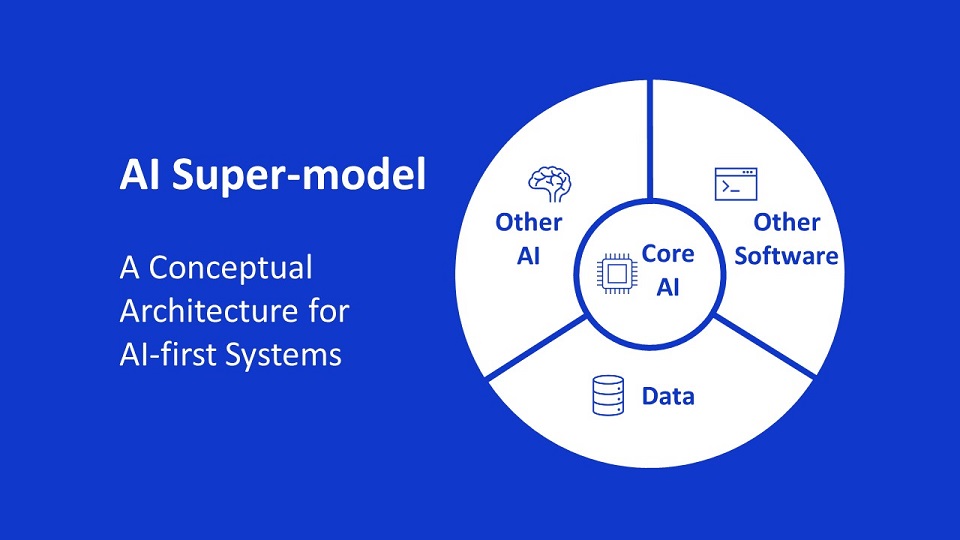Introduction
Welcome to the first in a series of articles where I will introduce and explore a new concept with the potential to redefine the relationship between artificial intelligence and software applications. I call this the “AI Super-model,” a conceptual architecture that embodies an integrative approach to harnessing the power of AI (including Large Language Models (LLMs), generative AI, and other AI elements) along with other aspects of software.
 In subsequent articles, we will delve deeper into the elements of the AI Super-model architecture, examine the roles of various players in its evolution, and assess its impact on them. Your thoughts and feedback on this initial article will be invaluable, as I plan to publish more insights within the next few days. Feel free to comment on any aspect of this and suggest any future areas that you would like me to explore further.
In subsequent articles, we will delve deeper into the elements of the AI Super-model architecture, examine the roles of various players in its evolution, and assess its impact on them. Your thoughts and feedback on this initial article will be invaluable, as I plan to publish more insights within the next few days. Feel free to comment on any aspect of this and suggest any future areas that you would like me to explore further.
Large Language Models and Generative AI: Powerful but Incomplete
In the rapidly evolving world of AI, Large Language Models (LLMs) and other generative AI models have emerged as powerful tools with capabilities that extend beyond mere answers. They can generate text, code, and other artifacts, synthesize information, evaluate scenarios, give suggestions, and much more. However, despite these multifaceted abilities, they remain raw and do not serve as complete industrial-strength applications for most business and consumer needs. They are incredibly useful, wondrous, and rapidly changing, but my point is that they are not whole solutions for many of our requirements.
Full solutions must do much more – represent an entity (agency), work toward goals, understand context, and sequence work. Moreover, their decision-making abilities must transcend mere data processing to embrace a comprehensive understanding of relevant factors within specific domains and dependencies, while also being efficient.
From user interface, data storage, and memory to context, agency, security, and beyond, there’s a substantial gap to be bridged. The complexity of managing security, filtering content to remove bias and hallucinations, and adhering to policies and norms adds to the challenge.
The current solutions, including ChatGPT and Bard, are testaments to progress but are not intended to be such comprehensive solutions. Moreover, it’s worth noting that AI may not always be the most efficient tool for every task; in some instances, deterministic or non-AI software solutions may be more appropriate.
Reimagining a Bank Interaction
Imagine walking into a modern bank branch to apply for a car loan. The bank associate assisting you relies on a ChatGPT-like application to answer your questions and guide you through the process. However, several challenges quickly become apparent:
- Lack of Specific Information: The application can’t provide real-time details such as current interest rates or tailor options to your financial situation.
- Inability to Process Requests: If you wish to check the status of an application or start a new one, the application falls short.
- Authorization Issues: Ensuring the associate has the proper authorization to view specific information is beyond the application’s capability.
- Unfit User-Interface: Initiating a new application is cumbersome as the application lacks the appropriate interface, forcing the associate to juggle multiple integrated systems.
The current system fails to harness AI’s full potential, restricting the associate to a piecemeal, disconnected experience.
An intermediate solution might be to augment the associate with a new interface, possibly fine-tuned with bank-specific data or enhanced through techniques like Retrieval-augmented Generation. This incremental change offers some value and efficiency but remains confined within today’s application infrastructure.
Yet, the true potential unfolds when we embrace the AI Super-model, where the human associate is empowered by an adaptive AI-driven system. In this future, the human associate remains at the core of your banking interaction but is enhanced by an AI-driven system that integrates Large Language Models (LLMs) and other AI elements, along with various other aspects mentioned above. This ensures a seamless, dynamic experience that adapts to individual customer needs. The bank associate can provide personalized financial advice, accept the necessary new information more easily without laborious forms, gather other relevant information, and adapt proactively to customer requirements. The result is a bank associate who doesn’t lose the human touch but gains a robust, flexible AI assistant that comprehends the bank’s offerings, the broader economic context, and myriad factors influencing financial decisions. Together, the human associate and AI form a comprehensive, natural, and responsive banking experience, marrying the best of human insight with cutting-edge technology.
The AI Super-model Concept
The key shift is moving from an “application” paradigm where AI fits in, to an AI-first paradigm in software where AI leads the way while integrating all AI and other necessary elements. Hence the term the AI Super-model.

The key aspects can be summarized as follows:
🎛️ CORE AI: AI serves as the overall orchestration mechanism across all facets, including other AI and software.
📈 OTHER AI: A significant increase in the use of AI (LLMs, generative AI, and other aspects of AI) to codify knowledge, processes, decisions, and all other aspects.
🛠️ OTHER SOFTWARE: Other supporting components needed including agency, workflow, context management, controls, security, and more.
📊 DATA: Internal and external data for operational and other needs.
By integrating various components such as AI-guided agency, workflow management, and contextual understanding, this architecture forms a unified framework that can serve diverse business needs. From real-time decision-making to autonomous workflow optimization, the AI Super-model provides solutions that align both technical capabilities with business sensibilities.
The concept of the “AI Super-model” is not merely a theoretical aspiration. It is grounded in the ongoing evolution of AI models, recent research around derivative models, and a profound understanding of business needs and commercial opportunities for such integrated systems. I present this perspective not as an AI scientist but as an observer of the technological landscape and business requirements, and IMHO, the implications are far-reaching.
The AI Super-model presents a promising but uneven journey ahead. Innovative start-ups may pioneer new systems embracing this concept, while established enterprises might evolve more gradually. The path will differ across industries, applications, and organizations, with some advancing rapidly and others lagging due to technological or regulatory constraints. Factors such as existing infrastructure and market dynamics will influence this complex transition. The adoption of the AI Super-model will require thoughtful planning and a keen understanding of both potential rewards and inherent complexities.
Roles of Various Players
In presenting the “AI Super-model,” we offer executives and managers a novel approach to leveraging the might of Large Language Models (LLMs) and other generative AI elements, fostering a more flexible and repeatable approach. It’s not just a technological advancement; it’s a paradigm shift, marrying the best of AI’s capabilities with a structured, integrative framework. Here’s a deeper look into the various players in this transformative concept:
🚀 AI Providers: Leading LLM and other AI providers may channel their models to offer more powerful solutions that deliver enhanced business value.
💼 Domain-Specific Tech Giants: Major technology companies specializing in specific domains or vertical functions (e.g., SAP, FIS ) have an opportunity to embrace this new paradigm, balancing investment and potential cannibalization.
🌱 Start-ups: Expect to see innovative start-ups adopting this conceptual architecture to cater to consumer and business needs with fresh perspectives.
🏢 Enterprises: While standing to benefit the most, enterprises such as banks face the complex task of shifting to a new paradigm without disrupting current infrastructure. The transition to an AI-first approach must be handled with care, considering existing non-AI platforms that still serve a significant portion of customers.
The AI Super-model concept beckons both innovators and traditional businesses to consider not just where to apply AI, but how it can redefine entire technology stacks. This shift could unlock new opportunities and guide organizations into a future filled with intelligent systems.
As we begin to explore this concept, your insights are not only welcome but essential. This conversation is just starting, and your input can shape its direction. I encourage you to share your thoughts and suggestions, as they will inform our continued exploration of this transformative idea. Together, we may uncover new avenues and deepen our shared understanding of AI’s potential.
#AI #software



Leave a Reply